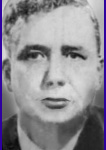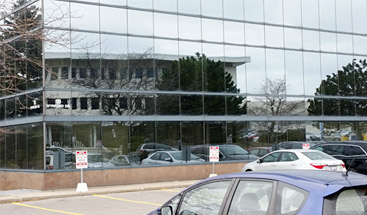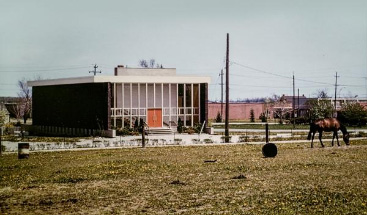A History of Don Heights
– – Vivian White 2004

Don Heights’ roots go back to 1953 when members of First Congregation who lived east of Toronto were told that they should start their own congregation. Led by Norman Abbott, they formed the East End Extension Committee, which met frequently to plan, and contacted other residents they thought might be interested. They organized the first public Unitarian service in Scarborough, which was held in Birch Cliff School on Sunday evening, February 7, 1954, with Rev. Bill Jenkins, minister of First, as the speaker. They continued to have their services in the evening to make it possible for him to be the speaker.
Another fellowship was formed in Don Mills in 1955, and in 1956 the two groups decided to merge, and called the new group Don Heights. Norman Abbott, chairman of the Birch Cliff board, now became the chairman of the Don Heights board.
Rev. Don Stout, who had been minister for both Birch Cliff and South Peel since 1954, moved to South Peel full-time in 1956. Rev. Jay Chidsey became the first minister of Don Heights, where he remained until 1964.
During the first four years, Sunday services were held in public school auditoriums and factory cafeterias. The School of Religion met in school classrooms and in the homes of various congregation members who had the space … and the fortitude.
We needed a place of our own. Several sites were considered and debated; one was even bought and sold again. Meanwhile we undertook many fund-raising schemes, including a high-quality arts and crafts fair called Medley, raffles, pickle-testing, newspaper delivery, sale of Christmas trees, and debentures. At last in 1959 a pleasant rural setting was found near Kennedy Road and Highway 401, and our building, designed by John Parkin, went up in 1960. Even so, for the next few years we were very crowded, especially with children; we rented space in Ellesmere Public School for R.E. classes, and for a time had double sessions.
In 1961 John Hearn initiated the production and sale of Christmas cards designed by four of our artist members, which we sold all across Canada to benefit the Unitarian Service Committee. Other Don Heights projects aided World Refugee Year, Canadian Mental Health Association, the Eye Bank and the Canadian Peace Research Institute. Two USC groups met weekly to sort, mend and pack donated clothing for shipment overseas.
The congregation donated the dining hall at a USC hostel for boys in India. We got involved with native Canadians and with the African Students Foundation. A nursery school for mentally retarded children was begun by Joyce Mino in our building and operated successfully until the professional qualifications were raised beyond our power to meet. It was in the sixties that our numbers were at their highest, creativity was flourishing, our doings were always in the news, and there was much involvement in social action.
The Stratford Festival Unitarian Weekends were dreamed up by Jay and carried on for several years. Ticket and accommodation packages were sold to Unitarians across Canada and in the U.S. Jay designed a special swan-shaped name tag so Unitarians from different places could identify each other and get acquainted.
An Arts Development Committee sponsored a number of cultural events, including excellent concerts and well-known speakers such as Irving Layton and Pierre Berton. These attracted many non-Don Heighters and brought us considerable press coverage.
In December 1962 a death watch ritual took place at Don Heights on the eve of what turned out to be the last executions carried out in Canada. Jay described the executions as “murder by the state – a calculated policy of revenge for murder done … barbaric, degrading, cold-blooded murder as useless as it is evil.” This initiative was strongly supported by the congregation, and the resulting publicity may even have contributed to the decision by Parliament in December 1967 to abolish the death penalty except in case of murder of a policeman or prison official.
Arlene Fraser was hired as Director of Religious Education in 1963, but a serious illness forced her to resign after only six months. Heather McDonald was hired to fill the position and stayed with us in that capacity for 17 years. She organized many imaginative projects, involving not only the children but the adults of the congregation, and people from the surrounding community. The School of Religion met some visitors from Japan and sent back with them a large paper crane to be placed in the Peace Park. The School adopted a Korean child, Won Sook, resident of a USC children’s home; and corresponded with other Unitarian children around the world. A very successful Family Cluster program was started, and intergenerational celebrations of holidays from our own and other cultures were instituted.
Before Jay left Don Heights in 1964 he helped us plan for the time that would elapse before we could get another minister. In other words, he trained us in lay leadership. Jay’s successor was Rev. Ken Helms, who was with us from December 1965 to May 1968, when we could no longer afford to pay his salary. From April 1970 to September 1973 we had Bill Jenkins as part-time minister. At the same time Eugen Fandrich, a Baptist minister, was hired as “part-time resource person”, and this arrangement continued until March 1972. He did some counselling and alternated with Bill Jenkins as Sunday speaker. He also delved into our old minutes, newsletters, etc., and wrote a history of the congregation. After leaving the position of resource person he served as our chaplain until July 1980. He subsequently returned to the Baptist fold.
From 1973 to 2000, Don Heights was lay-led. It must be mentioned, however, that Heather McDonald in many ways fulfilled the functions of a minister. She had a talent for discovering people’s skills and pressing them into service, thus making them feel more a part of the congregation.
Don Heights seems always to have known how to have fun, and we developed a reputation among Unitarians for our parties and revues. Some of the latter were “The Sound of One Hand Clapping” (1962), “Festival of Carol’s” (by John Hearn, 1967, also presented at the Royal Alexandra Theatre), “In One Ear” (1968, also presented at the Colonnade Theatre), “Hello, My Name is Harold” (1970), “Roarin’ Twenties Revue” (1979, part of our 25th Anniversary festivities), “A Night in Transylvania” (1980), “As the TV Sets” (1981).
1970s activities included dinners, parties, Easter breakfasts, visits to Heronvale (Dorothy Fletcher’s place in the country), Heather’s celebrations of festivals from many cultures, nature walks and picnics following Sunday service, some very memorable Christmas services, and a number of creative fund-raising projects.
Activities during the 1980s included the January Jump-Ups introduced by Chris Stoute, dream auctions, the Skills and Services Fair, the singles group Carousel, the Everything Sale, Creativity Day, guitar concerts organized by Olive Shaw, summer get-togethers and a Joyce Poley coffee house (1987). A Don Heights banner was created in 1985 by Betty Poole and Vivian White and was used at all CUC and UUA conferences at which we had representation. In 2000, a competition was held for a new banner design and won by Raquel Baranyai. The new banner (shown elsewhere on this website) is on display at all our services and attended its first conference in May 2001, the CUC AGM in Montreal.
Some Don Heighters participated in peace marches under the Unitarian banner, and in 1985 some painted human shadows on Toronto sidewalks during the night to commemorate the 40th anniversary of Hiroshima.
In 1985, led by Beverly Carr and John Plumpton, we embarked on a plan to redevelop our property and this absorbed most of our attention from then on. We sold our air rights to the Co-operative Housing Federation, enabling them to demolish our building and erect a ten-storey co-operative apartment building with space for Don Heights. The congregation was given the naming of the Co-Op and chose to name it after Bill White, a much-loved member of the congregation who had died in 1981. The building was completed in 1989.
Our new lectern was created for us by Steven Stairs. A stained glass window was designed for us by Tom Smylie and installed in our auditorium in 1994, and a large wall hanging symbolizing Don Heights was created for us by Helena Wehrstein in 1995.
We continued to rent our R.E. space during the week to Glamorgan Day Care Centre.
Activities during the 1990s included art shows and the use of a legacy from Olive Shaw to stage a concert by Liona Boyd. Subsequently we sponsored several other concerts, including the annual Inga Jarrett concert, and instituted a monthly coffee house for Don Heighters and friends. The Funstrummers, a musical group which used our space without charge for their weekly rehearsals, put on an annual concert to raise money for us. Summer services were begun.
An inward-looking period which began in the l980s was followed by a renewed interest in social action, exemplified by our involvement in “Out of the Cold”, contributions of food and money to Agincourt Community Services’ food bank, and the Christmas “Mitten Tree” donations were divided among these two organizations and Second Base Youth Shelter.
Attempts were made to be of service to residents of the neighbouring apartment buildings and townhouses.
Early in the 1990s a committee was formed to look into the feasibility and desirability of obtaining professional leadership for the congregation. Dinner meetings were held in homes and attempts made to ascertain the ideas of every Don Heighter. Eventually the hiring of a minister was approved by the congregation, but with such financial restrictions that it was impossible for anyone to be hired. A congregational meeting was held at which the motion was changed to specify “professional leadership” rather than “minister”. The committee arranged for Janet Vickers, who had served the congregation as chaplain, Sunday Services chair and office coordinator before moving to B.C., to come for three weeks and take the congregation through a process to determine what kind of professional was needed. The two top choices were “minister” and “facilitator”. A vote was taken, resulting in a close decision to hire a facilitator. John May was the successful applicant, and began his duties in April 1998. Sadly, John died in January 2001.
Our building had many problems due to poor construction. Repairs to the exterior cladding were urgently needed for safety reasons and the cost would be prohibitive. In 1998 the congregation gave its approval for selling the building, and this was done on December 23, 1998. We had expected to rent back our part of the building for at least five years, but instead we found that the purchaser wanted to use the space for some other purpose and wanted us out as soon as possible.
The next chapter in the life of Don Heights began with our move to the Civic Garden Centre in February 2000, where we rented space for our Sunday services and other gatherings. It was a very pleasant place to meet and attendance increased while we were there. Gerry Hobden worked long and hard to transform his recreation room to house the Don Heights office, board room and lending library. In January 2004, due to planned renovations at the Centre, we moved to rented space in an office building at 18 Wynford Drive in Don Mills. It is good to have room for our office, R.E., board room and minister’s office, as well as our congregational meeting space, all at the same address.
But our Location and Premises Team is still working on finding us our own building.
In September 2000, the congregation voted to hire Frances Deverell as our minister on a one-year contract.. She came on October 28th, and her first service as our minister was on November 12. In accordance with our agreement, she was our speaker twice a month, and on the other Sundays we had a lay person speaking on some topic of general interest. Frances was involved with every aspect of Don Heights’ life and was especially good with the children. Her warm and caring manner caused a further increase in attendance, and there was a new spirit of vitality in the congregation. The highly successful Inga Jarrett Memorial Concert in March 2001was to this long-time member reminiscent of events in our past with its enthusiastic involvement of so many members. In 2001, the congregation voted to hire Frances for a second year. She had initiated many new adult programs, and her Sunday services were extremely intelligent, caring and well prepared. One disappointment was that our R.E. did not grow, although the children we already had liked her very much. We hosted her ordination on June 16, 2002. In October 2002, a vote was held on whether to hire her as our settled minister. The result was one vote short of the required 2/3 majority, and further, because Frances wanted at least 85% support from the congregation, she could not remain with us. She is now minister of the Saskatoon congregation, where the vote in her favour was 100%!
In 2003 we hired Rev. Emily Morse Palmer as an interim minister for one year, ending in June 2004. She was well liked and we appreciated her sense of humour, although some of us resented her belief that it was her duty to change us and do away with our traditions. Our second interim minister, Rev. Charlotte Cowtan, will be coming to us in September 2004, again for one year only. Meanwhile, our Ministerial Search Committee is working to find us a settled minister.
Vivian White
August 2004
Further events subsequent to the end of Vivian White’s account:
We moved to 18 Wynford in 2004 where we regained the ability to hold services and programs anytime we desired. Rev. Debra Faulk was called to our congregation in 2006 and remained with Don Heights until 2010 when she moved to the Calgary Congregation.  At that point our lay-led congregation decided to have guest ministers and topical speakers on a 50/50 basis. In 2016, Don Heights purchased its space at 18 Wynford Drive when the building changed ownership. We continue to be a lay-led congregation with active Sunday Services, Social Action and Caring Committees.
At that point our lay-led congregation decided to have guest ministers and topical speakers on a 50/50 basis. In 2016, Don Heights purchased its space at 18 Wynford Drive when the building changed ownership. We continue to be a lay-led congregation with active Sunday Services, Social Action and Caring Committees.
Marion Wyse is undertaking to update and revise this history. We hope to publish her new version soon.

